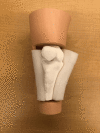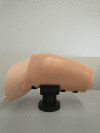Development of Simple and Advanced Adult Proximal Tibia Simulators for a Decentralized Simulation-Based Education Model to Teach Paramedics-in-Training the Intraosseous Infusion Procedure
- PMID: 36465780
- PMCID: PMC9711918
- DOI: 10.7759/cureus.30929
Development of Simple and Advanced Adult Proximal Tibia Simulators for a Decentralized Simulation-Based Education Model to Teach Paramedics-in-Training the Intraosseous Infusion Procedure
Abstract
Introduction During the COVID-19 pandemic, public health had advised practicing social distancing which led to the temporary shutdown of simulation laboratories or centralized simulation-based education model, shared spaces that healthcare workers such as paramedics use to train on important hands-on clinical skills for the job. One such skill is intraosseous (IO) access and infusion, the delivery of fluids and medication through the marrow or medullary cavity of the bone which provides fast and direct entry into the central venous system. This skill is critical in emergencies when peripheral access is not immediately available. To continue the training of paramedics in life-saving skills like IO infusion in the post-pandemic era, a decentralized simulation-based education (De-SBE) model was proposed. The De-SBE relies on the availability of inexpensive and flexible simulators that can be used by learners outside of the simulation laboratory. However, to date, there is a paucity of simulation design methods that stimulate creativity and ideation, and at the same time, provide evidence of validity for these simulators. Our exploratory research aimed to test a novel approach that combines components of development-related constraints, ideation, and consensus (CIC) approach to develop and provide content validity for simulators to be used in a De-SBE model. Materials and methods The development of the IO simulators was constrained to follow a design-to-cost approach. First, a modified design thinking session was conducted with three informants from paramedicine and medicine to gather ideas for the development of two IO simulators (simple and advanced). Next, to sort through, refine, and generate early evidence of the content validity of the simulators, the initial ideas were integrated into a two-round, modified Delphi process driven by seven informants from paramedicine and medicine. In addition, we surveyed the participants on how well they liked the CIC approach. Results The CIC approach generated a list of mandatory and optional features that could be added to the IO simulators. Specifically, six features (one mandatory and four optional) for the existing simple IO simulator and eight (three mandatories and five optional) for the advanced IO simulators were identified. Following a design-to-cost approach, the features classified as mandatory for the simple and advanced IO simulators were integrated into the final designs to maintain the feasibility of production for training purposes. The surveys with the participants showed that the CIC approach worked well in the group setting by allowing for various perspectives to be shared freely and ending with a list of features for IO simulator designs that could be used in the future. Some improvements to the approach included flagging for potential users to determine what works best concerning the mode of delivery (online or in person), and duration of the stages to allow for more idea generation. Conclusion The CIC approach led to the manufacturing of simple and advanced IO simulators that would suit a training plan catered to teach the IO access and infusion procedure decentrally to paramedics-in-training. Specifically, they have been designed in a manner that allows them to be made easily accessible to the trainees i.e., low costs and high mobility, and work cohesively with online learning management systems which further facilitates the use of a De-SBE model.
Keywords: 3d-printing; additive manufacturing; emergency medicine; intraosseous infusion; pediatric emergency medicine; pediatrics; simulation-based medical education; simulator; three-dimensional printing; training.
Copyright © 2022, Sivanathan et al.
Conflict of interest statement
The authors have declared that no competing interests exist.
Figures









Similar articles
-
Adapting the Gamified Educational Networking Online Learning Management System to Test a Decentralized Simulation-Based Education Model to Instruct Paramedics-in-Training on the Emergency Intraosseous Access and Infusion Skill.Cureus. 2024 Mar 4;16(3):e55493. doi: 10.7759/cureus.55493. eCollection 2024 Mar. Cureus. 2024. PMID: 38571855 Free PMC article.
-
The Development and Initial End-Point User Feedback of a 3D-Printed Adult Proximal Tibia IO Simulator.Cureus. 2022 May 30;14(5):e25481. doi: 10.7759/cureus.25481. eCollection 2022 May. Cureus. 2022. PMID: 35800805 Free PMC article.
-
Hands-On Practice on Sustainable Simulators in the Context of Training for Rural and Remote Practice Through a Fundamental Skills Workshop.Cureus. 2022 Sep 6;14(9):e28840. doi: 10.7759/cureus.28840. eCollection 2022 Sep. Cureus. 2022. PMID: 36225462 Free PMC article.
-
Intraosseous access in the prehospital setting: literature review.Prehosp Disaster Med. 2012 Oct;27(5):468-72. doi: 10.1017/S1049023X12001124. Epub 2012 Aug 9. Prehosp Disaster Med. 2012. PMID: 22877834 Review.
-
Simulation-based training in laparoscopic urology - Pros and cons.Indian J Urol. 2018 Oct-Dec;34(4):245-253. doi: 10.4103/iju.IJU_213_18. Indian J Urol. 2018. PMID: 30337778 Free PMC article. Review.
Cited by
-
Defining the Nature of Augmented Feedback for Learning Intraosseous Access Skills in Simulation-Based Health Professions Education.Cureus. 2023 Jul 14;15(7):e41869. doi: 10.7759/cureus.41869. eCollection 2023 Jul. Cureus. 2023. PMID: 37581153 Free PMC article.
-
Adapting the Gamified Educational Networking Online Learning Management System to Test a Decentralized Simulation-Based Education Model to Instruct Paramedics-in-Training on the Emergency Intraosseous Access and Infusion Skill.Cureus. 2024 Mar 4;16(3):e55493. doi: 10.7759/cureus.55493. eCollection 2024 Mar. Cureus. 2024. PMID: 38571855 Free PMC article.
-
Identification of a partnership model between a university, for-profit, and not-for-profit organization to address health professions education and health inequality gaps through simulation-based education: A scoping review protocol.PLoS One. 2023 Jul 10;18(7):e0288374. doi: 10.1371/journal.pone.0288374. eCollection 2023. PLoS One. 2023. PMID: 37428783 Free PMC article.
-
Identification of a partnership model between a university and not-for-profit organization to address health professions education and health inequality gaps through simulation-based education: A scoping review.PLoS One. 2024 Oct 24;19(10):e0311349. doi: 10.1371/journal.pone.0311349. eCollection 2024. PLoS One. 2024. PMID: 39446748 Free PMC article.
-
The Perceived Effectiveness of Various Forms of Feedback on the Acquisition of Technical Skills by Advanced Learners in Simulation-Based Health Professions Education.Cureus. 2023 Aug 28;15(8):e44279. doi: 10.7759/cureus.44279. eCollection 2023 Aug. Cureus. 2023. PMID: 37772244 Free PMC article.
References
-
- Maragakis Maragakis, LL. (2020. Coronavirus, Social and Physical Distancing and Self-Quarantine | Johns Hopkins Medicine . [ Nov; 2021 ]. 2020. https://www.hopkinsmedicine.org/health/conditions-and-diseases/coronavir... https://www.hopkinsmedicine.org/health/conditions-and-diseases/coronavir...
-
- Challenges for the beleaguered health care workforce during COVID-19. Cutler DM. JAMA Health Forum. 2022;3:0. - PubMed
LinkOut - more resources
Full Text Sources
Miscellaneous
